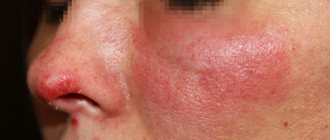: March 25, 2013, When science is ahead of fantasy, volume 48, no. 6
Smallpox, often called the scourge of humanity, was completely eradicated 35 years ago through mass vaccination and strict epidemic control. This is the first and so far only example of the global elimination of a particularly dangerous infectious disease by the world community. But has smallpox disappeared forever, and will this or another dangerous smallpox-like infection return again? To answer this question, you need to know how and when the causative agent of this disease appeared, how it adapted to the human body and understand the mechanisms of mutual evolution of pathogens and their hosts
Smallpox, or smallpox (not to be confused with chickenpox), is a particularly dangerous infectious disease that has claimed more human lives than other infections or even wars.
The causative agent of this disease caused such characteristic clinical manifestations of infection and caused such large-scale epidemics with a high mortality rate that many historians and doctors left written evidence about this disease. And although the records that have survived to this day are fragmentary and scattered and do not always allow us to reliably establish the cause of a particular epidemic outbreak, it can be confidently stated that since ancient times this disease has been found in a large area limited in the west by Egypt and in the east by China.
In different languages, the name of this disease sounds different, but they all point to its most noticeable manifestation - skin lesions: Staroslav.
– smallpox (from showering, rash);
lat.
– variola vera (variegated, spotted);
English
– smallpox (small – small, pox – skin rash);
French
– la petite variole (small spotting)
Since the period of the Crusades, epidemics of this devastating disease regularly arose on the European continent as a result of the introduction of infection from the Middle East: in the VI-VII centuries. outbreaks of smallpox were recorded in France, Italy, Spain and other European countries. The first mentions of severe smallpox epidemics in Russia date back to the 15th century, and starting from the next century, smallpox became so common in Europe that the attention of chroniclers was attracted only to cases of its extremely widespread distribution.
And even in the 20th century, in those less than eighty years when mass anti-smallpox vaccination was carried out and an intensive fight against smallpox was carried out using strict quarantine measures, at least 300 million people in the world died from this infection!
Chickenpox - definition
Chickenpox (also known as varicella) is an infectious disease of Chickenpox (Varicella).
It is caused by the varicella zoster virus. By the way, a close relative of the herpes familiar to many. All herpes are contagious, but varicella is the coolest. Chickenpox spreads through airborne droplets, and does so very actively. To catch an infection, sometimes it’s enough to look into the patient’s room for a second.
It always seemed to people that the disease was literally carried through the air, by the wind. Hence the first part of the name - wind. It was named smallpox because of the numerous rashes in the form of fluid-filled vesicles (papules), similar to those that form in smallpox.
Fortunately, chickenpox is not as deadly.
Smallpox
Despite the 40-year absence of detection of this disease in humans, virologists believe that it is too early to relax:
- After the elimination of the epidemic in the 70s, the disease began to affect the closest “relative” of humans – monkeys;
- Vaccination against smallpox is not included in the mandatory vaccination schedule. Therefore, the lion's share of people born after 1983 are not immune to this disease;
- If you look into history, you can safely assure that smallpox is capable of collapsing herd immunity and provoking the development of a pandemic.
Therefore, in every country in the world there is a stock of vaccines intended for mass immunization in the event of detection of this disease in people. Even people born in 1983 will have to undergo this procedure to develop a sufficient level of antibodies.
Chickenpox symptoms
Chickenpox usually lasts about ten days. The main symptom of chickenpox is a typical rash. One to two days before the rash appears, the following nonspecific symptoms may occur:
- Fever
- Decreased appetite
- Headache
- Fatigue and general malaise
The chickenpox rash goes through three stages of development:
- Pink or red spots and bumps (papules), which appear in spurts, with each new wave of fever, 2-6 shocks per day, for 3-6 days.
- After a few hours, these papules turn into blisters filled with clear liquid (vesicles), they last for a day, after which they burst and the liquid flows out
- After the blisters burst, after a few hours weeping appears - in their place crusts form, which last from several days to several weeks until new tender skin forms under them, after which they fall off.
Chickenpox: course of the disease
Chickenpox is characterized by stages, which allows you to assess the course of the disease and navigate the quarantine period.
The incubation period of chickenpox is the time that elapses between the virus entering the body and the appearance of the first symptoms of the disease. It usually lasts 2 weeks, but can range from 10 to 21 days. The incubation period for chickenpox in adults and children is usually the same length.
The prodromal period is the initial stage of chickenpox. It is short (1-2 days), and may be absent altogether. Its characteristic symptoms are poor health, fever, muscle and headaches, and catarrhal phenomena in the nasopharynx. The first symptoms of chickenpox in adults are usually more pronounced than in children.
The rash period lasts 3-10 days. Elements of the rash appear in waves, this is accompanied by an increase in body temperature and poor health. 1-2 days pass between “waves” of rashes. There are usually 2-5 of these “waves”, then new elements stop appearing and gradually heal. The next stage begins - healing.
The recovery period begins from the moment when new elements cease to form, and all that appear become covered with crusts.
The period of convalescence (recovery) after chickenpox can last up to 1 year. The varicella-zoster virus causes a serious blow to the human immune system, and the process of its recovery is usually quite long. During this period, the body's resistance to other viral infections, such as ARVI, decreases.
How many days chickenpox lasts depends on the individual characteristics of the disease, the patient’s age, and the state of his immunity. On average, from the moment the first signs of chickenpox appear in a child until the elements of the rash completely heal, 3 weeks pass; in adults it may be longer.
Types of chickenpox (classification of chickenpox).
Chicken pox occurs in typical and atypical forms and in terms of severity is mild, moderate and severe. Chickenpox is also classified according to ICD-10 (with meningitis, encephalitis, pneumonia).
Atypical forms of chickenpox are divided into:
- Hemorrhagic form - a common consequence of this form is bleeding, and this form occurs in people with thrombocytopenia.
- Pustular form - develops when a bacterial agent is attached.
- Gangrenous form - can lead to the development of sepsis and occurs most often in patients with weakened immunity.
- The generalized (visceral) form of chickenpox is characterized by development in patients with immunodeficiency. It is very difficult, the symptoms are more pronounced and often ends in death for the sick person.
- The rudimentary form is found in children who received immunoglobulin during the incubation period. It flows quite easily.
The severity of chickenpox is directly determined by the degree of intoxication syndrome and its criteria, as well as the presence of specific vesicular rashes on the skin and mucous membranes. It should be noted that there are also so-called abortive (very mild) cases of the disease, which occur without the appearance of fever and are characterized by the appearance of single rashes on the skin of the abdomen and back. Such chickenpox is detected in kindergarten during examinations during outbreaks.
To the question “how long does chickenpox last?” It is difficult to answer unequivocally, since the duration of the disease directly depends on the form and course of chickenpox. On average, in the classical (typical) course, the duration of the disease is from 12 to 16 days.
In a vicious circle
Variola virus is one of the largest and most complex mammalian viruses. Brick-shaped viral particles have relatively large sizes (250-300 × 200 × 250 nm), so after special staining they can be seen using a light microscope, which is impossible for other viruses. The variola virus genome is a linear double-stranded DNA molecule containing 187 thousand base pairs with covalently closed hairpin structures at both ends. The virus has about 200 genes in its genome, a huge number compared to most viruses of other families. Viral particles have several lipoprotein membranes and contain many structural proteins, as well as enzymes necessary for the reproduction of the virus in the host cell. The entire development cycle of the variola virus takes place in the cytoplasm of the cell in special structures called virosomes or viral factories.
If an acute infectious disease can quickly spread in the host population and lead to rapid death or recovery with the acquisition of immunity, then its outbreak should lead to a rapid depletion of the “reserve” of individuals sensitive to it. And if at the same time the causative agent of such a human infection loses the ability to reproduce in a pre-existing natural reservoir, i.e., in wild animals, then in a relatively small and sparse human population the epidemic will quickly fade.
In a large population of people with a high population density, the infection can be transmitted from one area to another, returning to the starting point years later, when a new generation sensitive to the pathogen has already been born and grown up. In this case, the anthroponotic infection will be maintained in a certain area for many years, turning into the so-called endemic state
.
The oldest surviving descriptions of smallpox date back to the 4th century.
(China) and 7th century. (India and the Mediterranean), define this disease primarily as a childhood infection, with the highest mortality rate among children. This indicates that the disease was already endemic at that time in these densely populated geographic areas. In India, despite the centuries-old endemicity of the disease and the long-term co-evolution of the smallpox virus and the population of this region, the mortality rate among unvaccinated children under 5 years of age during smallpox epidemics that periodically occurred there even in the 20th century. could reach 50% (Fenner et al.
, 1988). This is due to the fact that the variola virus has a multifactorial system for effectively overcoming numerous protective reactions of the human body directed against infectious agents (Shchelkunov, 2011; Shchelkunov, 2012). Therefore, the likelihood of genetic adaptation of the human population to this virus, which would significantly reduce the degree of its pathogenicity for humans, is extremely low.
Over the past centuries, evolution has largely affected the virus itself. At the same time, in the most densely populated and vast territories (the Indian subcontinent), smallpox epidemics occurred with the highest mortality rate, and in regions with low population density - with a lower one.
Diagnosis of chickenpox
The basis for detecting herpes is a virological study - examination of media to detect the pathogen. In case of chickenpox, for diagnosis, liquid from vesicles is used, in which, when stained, accumulations of the pathogen, the Argan corpuscle, are isolated.
Chickenpox is usually distinguished from insect bites. The main difference is the lack of development of elements and bedding, as well as normal body temperature.
Also, the disease should be differentiated from:
- streptoderma - occurs without fever, the rash is different - cloudy, purulent contents, after involution leaving a yellow crust, in its place a red spot forms. The rash is located mainly behind the ears and on the extremities, never on the scalp (a hallmark of chickenpox).
- herpes zoster - the blisters are located strictly along the nerve trunk; they practically never occur on the legs and arms.
- vesicular rickettsiosis - a small scab forms at the site of the tick bite, followed by the formation of an ulcer (a scar forms in its place after healing). Enlargement of regional lymph nodes is typical.
Contraindications
A live vaccine always poses some threat. After all, it can cause a mild form of the disease. And such a situation is dangerous for people with low immunity - their body is simply not able to protect itself from complications. Therefore, the chickenpox vaccine is not given:
- Patients with HIV;
- In immunodeficiency conditions - age-related or arising after a serious illness, surgery;
- For chronic diseases of the heart, liver and kidneys;
- For ARVI and colds;
- Pregnant and nursing mothers are not given vaccinations.
The presence of an allergy to one of the components of the biological product can also become a serious limitation.
When to see a doctor?
If you suspect that you or your child has chickenpox, consult your doctor. The doctor will be able to make a diagnosis simply by examining you, studying the elements of the rash and accompanying symptoms. Your doctor may also prescribe medications to reduce the severity of chickenpox and reduce the risk of complications, if necessary. Call the pediatrician in advance and warn that you suspect chickenpox - the doctor will see you in a separate room, without waiting in line, to avoid the risk of infecting other patients.
Also, be sure to tell your doctor if you have any of these complications:
- The rash has spread to one or both eyes.
- The skin around some parts of the rash becomes very red, hot, or painful, indicating a secondary bacterial skin infection.
- The rash is accompanied by dizziness, disorientation, rapid heartbeat, shortness of breath, tremors (shaking hands), loss of muscle coordination, increasing cough, vomiting, difficulty bending the head forward, or a fever above 39.4 C.
- a history of any immunodeficiency, or age younger than 6 months.
Indications
Today, smallpox vaccination is not mandatory and is given only to people whose risk of infection is higher than others:
- Employees of epidemiological surveillance authorities;
- Doctors and medical staff of infectious diseases departments;
- Virology laboratory specialists;
- Workers of disinfection teams and units;
- To scientists and personnel working with great apes.
If an infection is registered in one of the districts, doctors, nurses, ambulance drivers, and reception workers will also have to be vaccinated. You can get vaccinated against smallpox at your own request. Especially if you think you have this infection and are at risk of contracting it. All you have to do is contact the clinic - the vaccine will be delivered to order within a strictly defined time frame.
How to treat chickenpox
Chickenpox is a virus. And, like most viruses, there is no specific treatment for it. Helping a sick person comes down to alleviating the main symptoms.
Fever and headache
Remember: paracetamol and nothing else! Popular painkillers and antipyretics based on ibuprofen should not be taken. The use of nonsteroidal anti-inflammatory drugs and the risk of serious skin and soft tissue complications in patients with chickenpox or herpes zoster have been reported to indicate that ibuprofen for chickenpox increases the incidence of complications such as skin infections.
Aspirin is completely contraindicated. In conjunction with the varicella-zoster virus, it has a powerful toxic effect on the liver and brain (the so-called Reye's syndrome).
Itching
To relieve itching, your doctor may recommend an antihistamine. Considering the insidiousness of the virus, under no circumstances prescribe it to yourself!
You can also treat your skin with calamine lotion according to the instructions.
Scratches and wounds
To avoid scratching the skin and causing infection in the wounds:
- Trim your nails as short as possible. If your baby is sick, put on thin protective gloves.
- Wear clean, loose clothing.
- Change your underwear and bed linen more often.
It is not necessary to smear the rashes with brilliant green: brilliant green will not speed up the maturation of the blisters. The color only helps to mark pimples in order to track the moment when new ones stop appearing.
Soreness in the mouth
If there are rashes on the oral mucosa, doctors recommend eating sugar-free popsicles. The cold will help relieve discomfort. Also try not to eat salty and spicy foods.
What complications can occur with chickenpox?
The disease is usually mild, but complications may occur, including bacterial infections (eg, bacterial skin lesions, pneumonia) and neurological infections (eg, encephalitis, meningitis, myelitis), which can be fatal.
Secondary bacterial skin infections, which are caused by streptococcus or staphylococcus, are the most common cause of hospitalization and outpatient medical visits. Secondary infection with invasive group A streptococci can cause abscesses and cellulitis.
Pneumonia after chickenpox is usually viral, but can also be bacterial. Secondary bacterial pneumonia is more common in children under 1 year of age. It is characterized by an increase in temperature up to 40⁰C, an increase in pallor and cyanosis of the skin, the appearance of a substernal dry cough and shortness of breath. Patients can take a forced position in bed.
Damage to the central nervous system in chickenpox ranges from aseptic meningitis to encephalitis. Cerebellar involvement followed by cerebellar ataxia is the most common presentation of central nervous system disorders but usually has a positive outcome.
Encephalitis is one of the most dangerous complications of chickenpox (10-20% of cases are fatal). This complication manifests itself as headache, nausea, vomiting, convulsions and often leads to coma. Diffuse brain involvement is more common in adults than in children. Chickenpox meningitis may occur together with encephalitis or independently.
Rare complications of chickenpox include Guillain-Barré syndrome, thrombocytopenia, hemorrhagic and bullous chickenpox, glomerulonephritis, myocarditis, arthritis, orchitis, uveitis, iritis and hepatitis.
Once infected, the virus remains hidden in nerve cells and can be reactivated, causing a secondary infection, herpes zoster. It usually occurs in adults over the age of 50 or with a weakened immune system and is associated with a painful rash that can cause permanent nerve damage.
Chickenpox and pregnancy
A special type of complications from chickenpox can occur in pregnant women. Chickenpox in early pregnancy can lead to a variety of problems in the newborn, including low birth weight and birth defects such as limb abnormalities. A particularly great threat to the child occurs when the mother gets chickenpox a week before giving birth. In this situation, there is a high risk of infection that is life-threatening to the newborn (congenital chickenpox syndrome).
If you are pregnant and have been in contact with someone who has chickenpox, be sure to talk to your doctor about the risks to you and your unborn baby.
First Comings
It is believed that smallpox originated in the region of Egypt (Middle East), however, in the numerous regional written sources that have reached us from that time, there is no mention of epidemics of this disease. Therefore, it is worth considering an alternative option related to the history of the ancient highly developed Indus (Harappan) civilization, which was discovered by archaeologists only in the 1920s. (Albedil, 1991).
"COOL" GODDESS
Shitala, the Hindu goddess of smallpox, occupies a very special place among the countless personifications of Devi, the variety of which is so rich in Hinduism. Her cult is widespread throughout almost the entire territory of Northern and Central India, from Sindh and Gujarat in the west of the country to Bengal, Assam and Orissa in the east, as well as outside the country - in Bangladesh and Nepal. Despite some variability in iconography, Sheetala is easily recognizable: she is depicted riding a donkey, naked or dressed as a married woman, often as an elderly Brahmin woman. She had a fan on her head, a broom and a vessel with water in her hands. The cult of this goddess obviously developed quite late - the first mentions of her appear in medical treatises of the 16th century, although descriptions of the disease itself are found in texts created long before the beginning of our era. Judging by many signs, the cult of Shitala is folk in origin and was not immediately included in Hindu religious ideas. Thus, there is no mention of Shitala in the early Brahminical texts, and its priests to this day are for the most part not Brahmins, but representatives of the low caste Malakars. In some places, blood sacrifices are still made to the goddess, although in general she prefers bloodless offerings - coconuts, cold rice, sweets and other “cooling” foods. The goddess, born from the cooled ashes of a sacrificial fire, hates heat and always seeks coolness, rewarding those who can appease her and punishing careless adherents with the heat of smallpox. It is not surprising that within these ideas, smallpox was seen not as a dangerous disease, but rather as the result of the manifestation of the presence of an angry deity. Therefore, treatment of a patient with smallpox primarily included procedures aimed at cooling the body of the unfortunate victim of divine rage: cold drink, fanning, wiping the body with ice water or wet leaves of the neem tree - the favorite plant of the goddess, truly known for its effectiveness against many skin diseases. All these actions were accompanied by chants addressed to Sheetala. The highest mortality rate from smallpox was recorded in India during the hot, dry months of the year, from February to April, decreasing sharply towards the beginning of the rainy season. Therefore, smallpox in India was often called a spring disease, and Shitala, accordingly, a spring goddess (the main holiday dedicated to her falls in mid-March). And today, during the holiday, in order to avoid the wrath of the “cool” goddess, any “warming” actions are prohibited - cooking hot food, eating spices, lighting fires in houses, as well as marital relations. Although the name of this goddess is primarily associated with smallpox, her character is very multifaceted. For example, Sheetala is also considered the protector of children and the giver of good fortune. But although the features of the cult may vary from place to place, the main characteristic of the goddess remains unchanged - she is always “cool” (this is how her name is literally translated from Sanskrit). Today, "cool" Shitala is more than a local deity protecting against smallpox: she serves as a symbol and constant living reminder of the need to maintain the correct balance of heat and cold in the human body. Violation of this balance, causing the wrath of the goddess, can lead to the emergence of a dangerous disease.
K. M. Vozdigan, senior specialist of the exhibition department of the Museum of Anthropology and Ethnography (Kunstkamera) RAS, St. Petersburg
About 2.5 thousand years BC. e. in a long river valley The largest cities of that time appeared on the Indus River, the population of which by the beginning of the 2nd millennium BC. e. was about 5 million people. However, for an unknown reason, 1.8-1.6 thousand years BC. e. these cities were depopulated. There is no evidence that they died as a result of wars or natural disasters; Moreover, during excavations of the largest city of Mohenjo-Daro, numerous human remains were found on the streets without visible wounds or damage, despite the fact that, as archaeologists have established, cremation of the dead was typical for this culture.
The most obvious explanation for the collapse of the Indus civilization, one of the three most ancient civilizations of mankind, along with the ancient Egyptian and Sumerian, may be an epidemic of a fatal disease. Since the time of occurrence of the smallpox virus (3.4 ± 0.8 thousand years ago) corresponds well to the period of a sharp decline in the population of the Indus Valley (3.8-3.6 thousand years ago), it can be assumed that it was smallpox in As a new deadly infection, it became the cause of mass epidemics among the local population, which had no immunity to it, which led to a sharp decrease in its population (Shchelkunov, 2009). The size of this human population appears to have prevented the infection from becoming endemic, and this highly virulent human infectious agent has disappeared.
However, its zoonotic progenitor (or a low-virulent variant of variola virus with a wide host range) apparently continued to circulate in a natural reservoir (rodents) over a large area. This situation is typical for any new highly lethal human infection: the most famous example is the Spanish flu epidemic in 1918-1919.
Researchers of ancient manuscripts, including the Talmud and the Bible, did not find in them descriptions of epidemics of a strictly anthroponotic infection with skin rashes resembling smallpox. However, if we use the assumption put forward above that the causative agent of smallpox originated from an orthopoxvirus with a wide range of hosts, which in the first stages of adaptation to humans of smallpox retained the properties of a zoonotic infection with little pathogenicity for humans, then in the text of the Bible we find the description we need, relating to the time of the exodus Jewish people from Egypt (14th century BC): “... and there was inflammation with boils on people and on livestock throughout the whole land of Egypt” (Exodus, the sixth plague of Egypt).
This indicates that in Egypt and the Middle East, already in ancient times, epidemics of zoonotic infection of people and domestic animals with skin rashes on the body, not accompanied by death, apparently occurred (Shchelkunov, 2011).
In modern times, smallpox showed its deadly power after the discovery of America by Europeans. During the XVI-XVII centuries. it was repeatedly brought to the New World from Europe and West Africa along with slaves. The indigenous population of America never encountered this infection, so smallpox became a terrible disaster for them - some tribes died out almost completely. It is known that in Mexico alone in 1520, smallpox claimed about 3.5 million lives! Only after powerful smallpox epidemics passed through both American continents did the disease become endemic with a low (less than 1%) mortality rate. The population of South and North America at the time of Columbus’s landing was about 70 million people, but as a result of similar epidemics and, to a much lesser extent, wars, by 1800 it had decreased to 600 thousand people
It is possible that the mysterious “catastrophe” of the Bronze Age in the Middle East and Eastern Mediterranean, dating back to 1.2-1.1 thousand years BC, is also connected with the smallpox epidemic, but with a high mortality rate. e. This period is characterized by a sharp decline in the human population of this vast region, the destruction of cities and catastrophic changes in social structure (Robbins and Manuel, 2001). And it was from this time that two of the three Egyptian mummies found with skin lesions characteristic of smallpox date back to this time (Fenner et al.
, 1988).
It can be assumed that during this period, in the region of the Middle East and Eastern Mediterranean, where several million people lived, a virus dangerous to humans re-emerged, but the insufficiently high human population again did not allow the new anthroponotic infection to become endemic and persist.
The next “coming” of smallpox occurred in the middle of 1 thousand years BC. e. on the Indian subcontinent. Here, in the Ganges Valley, by that time the largest (about 25 million people) and dense human population had formed. Obviously, this population size was already sufficient for the newly formed highly pathogenic strain of the virus to become endemic.
At this time, among the European countries, the most populous was Greece, whose population by 400 BC. e. was approximately 3 million people. In both Greece and the Middle East, smallpox apparently was not observed at that time: at least, there were no epidemics in the army of Alexander the Great on the way from the Mediterranean Sea to India. But during the stay of this army on the territory of the Indian subcontinent in 327 BC. e. There was an outbreak of the disease with skin lesions characteristic of smallpox.
The transition of smallpox to an endemic state in the Indian subcontinent ensured the persistence of this highly pathogenic agent for humans for many centuries, until the 20th century. From here, this disease gradually spread throughout the world, and it was possible to eliminate it on a global scale only in the second half of the last century with the help of special preventive vaccinations.
Is it possible to wash yourself if you have chickenpox?
“Is it possible to swim if you have chickenpox?” is an age-old question parents ask their pediatrician. The answer depends on the patient’s well-being. In general, bathing with chickenpox is not only safe, but even beneficial - keeping the skin clean reduces the risk of secondary infection and promotes faster healing. However, at high body temperatures, it is better to refrain from water treatments and limit yourself to treating the rash elements with antiseptics.
If you have chickenpox, you can bathe in a weak solution of potassium permanganate or with herbal decoctions, but it is better to refrain from using cosmetics (shower gels and even soap). It is also undesirable to use washcloths and towels, as they can injure the skin.









